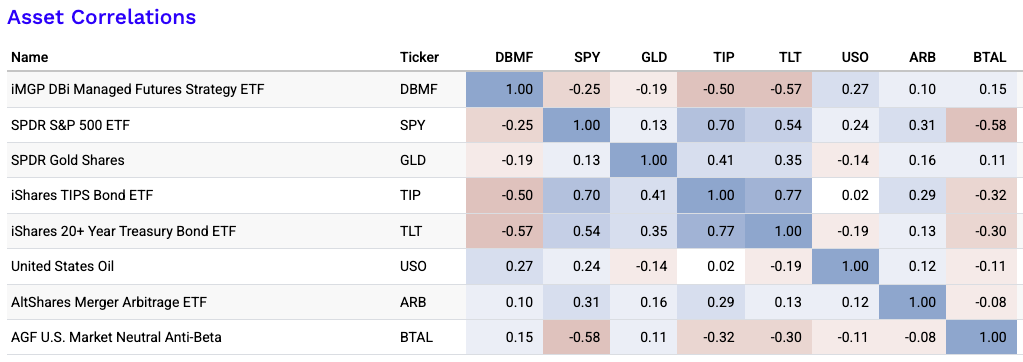CTA ETFs: Managed Futures for Public Investors

CTA ETFs offer retail and institutional investors access to managed futures strategies – typically the domain of hedge funds and institutional separate accounts – via a liquid, exchange-traded format.
These ETFs aim to replicate the core features of Commodity Trading Advisor (CTA) strategies: trend-following exposure across asset classes, long/short flexibility, and low correlation to traditional equity and bond portfolios.
They do so through systematic models that trade futures contracts on commodities, currencies, fixed income, and equity indices.
We’ll look at several of them in this article.
Key Takeaways – CTA ETFs
- CTA ETFs provide liquid, low-fee access to hedge-fund-style trend-following across asset classes.
- Summary of Key CTA ETFs:
- DBMF replicates institutional CTA positions;
- KMLM uses transparent, rules-based signals;
- CTA adds option-based volatility hedges;
- FMF applies a multi-factor quantitative model with muted trend exposure.
- Important to weigh signal type, asset coverage, fees, and responsiveness when choosing a CTA ETF.
- Other non-CTA ETFs from the “Alternatives” category explored.
Key CTA ETFs and How They Differ
DBMF – iMGP DBi Managed Futures Strategy ETF
- Manager – Andrew Beer / Dynamic Beta Investments
- Approach – DBMF uses a replication strategy, estimating the aggregate positioning of the largest CTA hedge funds in the SG CTA Index. It then constructs a portfolio of liquid futures designed to mimic those exposures.
- Features – It offers broad, institutional-style managed futures exposure at a relatively low cost (~0.85% expense ratio), with full daily transparency. DBMF has gained popularity as an “alternative diversifier” in portfolios with stocks and bonds
KMLM – KFA Mount Lucas Managed Futures Index ETF
- Manager – KraneShares
- Approach – KMLM tracks the Mount Lucas Managed Futures Index, which applies a classic trend-following system across 11 commodity, currency, and interest rate futures using price signals like moving averages.
- Features – It is rules-based and long/short, with equal risk-weighted allocation across asset classes. It appeals to investors seeking a more traditional, signal-driven CTA exposure without hedge fund layers.
DBMF vs. KMLM
DBMF tries to replicate hedge fund positioning using regression analysis and factor mapping, while KMLM is a direct, transparent rules-based strategy.
DBMF changes positions monthly based on hedge fund activity. KMLM is faster-moving, adjusting as signals shift.
CTA – Simplify Managed Futures Strategy ETF
- Manager – Simplify Asset Management
- Approach – Uses a rules-based trend-following strategy, but overlays option-based hedges and tail-risk overlays to manage downside volatility.
- Features – Combines managed futures with volatility mitigation, which can appeal to advisors seeking smoother ride during volatile markets.
FMF – First Trust Managed Futures Strategy Fund
- Manager – First Trust
- Approach – Uses a proprietary quantitative model to determine long, short, or flat positioning across equities, rates, and commodities.
- Features – Tends to have more muted beta to trend-following indices. It’s a broader multi-factor model, not purely momentum-driven.
What to Consider When Choosing a CTA ETF
- Trend Replication vs. Direct Signals – Replicators like DBMF aim to match institutional CTAs, while KMLM and CTA use first-principles signal generation.
- Fees and Transparency – ETFs like DBMF and KMLM offer hedge-fund-like exposure with lower fees and daily holdings visibility.
- Market Coverage – Consider how many futures are used and how diversified the exposure is across commodities, currencies, rates, and equities.
- Rebalancing Frequency – More frequent signal updates may lead to higher responsiveness but also more trading costs.
Correlations to Traditional Asset Classes
CTA ETFs typically exhibit low to negative correlations with traditional asset classes such as stocks, nominal bonds, inflation-linked bonds, gold, and oil (as seen in the image below).

Correlations are not static.
Nonetheless, this decorrelation highlights their value as diversifiers, offering potential performance resilience during equity drawdowns, interest rate shocks, or inflationary disruptions.
Such uncorrelated return streams make CTA strategies attractive additions to multi-asset portfolios looking for risk-adjusted balance.
Other ETFs with Low Correlation to Traditional Asset Classes
Here are several types of ETFs that often show low correlation to traditional asset classes like stocks and bonds, including arbitrage strategies and other alternative approaches:
The best…
Merger Arbitrage ETFs
- Example – ARB – AltShares Merger Arbitrage ETF
- How It Works – Invests in announced merger deals—long the target company, possibly short the acquirer—aiming to capture the spread.
- Correlation – Typically low correlation to both equities and fixed income because returns are driven by deal outcomes, not market direction.
Market Neutral ETFs
- Example – BTAL – AGFiQ US Market Neutral Anti-Beta ETF
- How It Works – Long low-beta stocks, short high-beta stocks. Seeks market neutrality by balancing exposure.
- Correlation – Very low correlation to market beta; often acts as a hedge during equity drawdowns.
Our correlation matrix with ARB and BTAL added (past correlations not necessarily indicative of future correlations):

Only moderately…
Volatility Strategy ETFs
- Example – SVOL – Simplify Volatility Premium ETF
- How It Works – Uses VIX options or futures to capture volatility risk premium or hedge against volatility spikes.
- Correlation – Inverse or low correlation to equities – can spike in value when markets fall.
Options-Based or Hedged Equity ETFs
- Examples – JHEQX, PUTW, SWAN
- How It Works – Use options (puts, collars, etc.) to hedge downside risk or generate income.
- Correlation – Partial equity exposure with reduced beta and lower correlation during market stress. Not the best for diversification to equities, so can be overrated for this purpose.
And potentially…
Crypto Asset ETFs
- Examples – BITO (Bitcoin futures), ETHE (Ethereum trust)
- How It Works – Provide exposure to cryptocurrency price movements or blockchain ecosystems.
- Correlation – Correlation can shift, but often uncorrelated with traditional fixed income and only loosely correlated with equities.
Conclusion
CTA ETFs provide a compelling option for diversification, especially during macro dislocations or equity drawdowns.
By offering access to trend-following across asset classes, they bring institutional strategies to the retail shelf – liquid, transparent, and tax-efficient.